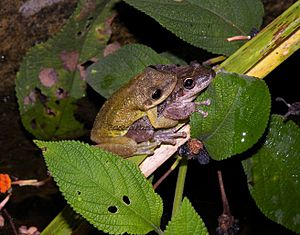Scinax ruber facts for kids
Quick facts for kids Scinax ruber |
|
|---|---|
 |
|
| Conservation status | |
| Scientific classification | |
| Synonyms | |
|
Hyla rubra Laurenti, 1768 |
The Scinax ruber is a type of frog that belongs to the Hylidae family, also known as tree frogs. People often call it the red snouted treefrog or red-snouted treefrog. Sometimes it's also called Allen's snouted treefrog.
This frog lives in many places. You can find it across a large part of the Amazon and along the northern coast of South America. It also lives in Panama and has been introduced to some Caribbean islands. Scientists believe this frog is actually a group of very similar species that look almost identical.
Contents
Where the Red Snouted Treefrog Lives
The Scinax ruber is found in many areas, from sea level up to about 2,600 meters high. It lives all over the Amazon Basin and the Guiana Shield in South America. This includes countries like Brazil, Colombia, Ecuador, French Guiana, Guyana, Peru, Suriname, and Venezuela.
You can also find it in central Panama and the eastern lowlands of Darien Province. It lives in Trinidad and Tobago too. This frog has also been brought to other places by humans. It is now an introduced species on Martinique, Puerto Rico, and Saint Lucia. On Martinique, it is considered an invasive species. This means it can sometimes cause problems for the frogs that naturally live there.
What the Red Snouted Treefrog Looks Like
Adult male Scinax ruber frogs are usually about 2.9 to 4.1 centimeters (1.1 to 1.6 inches) long. Adult females are a bit larger, measuring about 3.7 to 4.4 centimeters (1.5 to 1.7 inches). This measurement is taken from their snout (nose) to their vent (where waste leaves the body).
Their snout is rounded, not pointy. They have a clear eardrum, called a tympanum, on the side of their head. Their skin on their back is smooth or has very small bumps. The back of the frog is usually tan or a dull green color. It often has a wide, creamy tan or yellow stripe along its sides. This stripe has dark edges and goes from the eyelid all the way to the lower back.
Sometimes, there is also a broken tan stripe down the middle of their back. Their sides are cream-colored with yellow spots. These spots often have black edges near their groin area. The back of their thighs is brown with yellow or orange patterns. Their eyes are bronze with black lines. The underside of their body is yellow.
Habitat and Conservation
The Scinax ruber is a very common frog. You can find many of them in temporary pools of water during the rainy season. They live in many different places, from open areas to wet forests. They also like gardens and parks. These frogs live from sea level up to 2,600 meters (about 8,500 feet) above sea level.
They are nocturnal, meaning they are active at night. They are also arboreal, which means they spend most of their time in trees. These frogs usually lay their eggs in small, temporary pools. However, they can also use ditches along roads for breeding.
This frog is common and lives in many places. It is not facing any big threats right now. Because of this, the IUCN (International Union for Conservation of Nature) lists it as a species of "least concern". This means it is not in danger of disappearing. The Scinax ruber can adapt to different environments. It also lives in many protected areas, which helps keep its populations safe.
Images for kids
See also
 In Spanish: Ranita listada para niños
In Spanish: Ranita listada para niños




